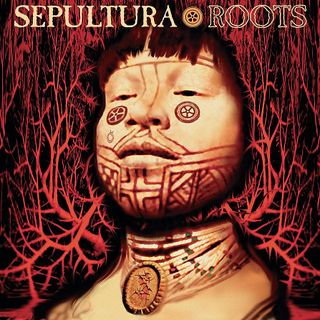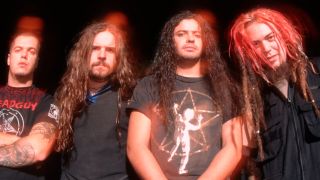Sepultura were one of the most evolutionary metal bands of the 1990s. The Brazilians originally rose from the slums of Belo Horizonte playing a particularly anarchic and nascent form of thrash. Then, they slowed to a stomping groove metal pace on 1993’s Chaos A.D.: two years after grunge and Metallica’s Black Album made high-speed rage passé. That change let the band fly – scoring commercial success and major-label deals – while so many of their extreme peers tumbled out of relevance.
In 1996, Sepultura reinvented themselves once again to reach the apex of their excellence. Singer/guitarist Max Cavalera had been introduced to early nu metal by his late stepson, Dana Wells, and – years before the genre ruled the mainstream – he mixed its hallmarks with the music of the Brazilian rainforest to make Roots. The album’s lead single, Roots Bloody Roots, was released on February 18 – swiftly afterwards, the band behind it were among the biggest in metal.
Roots Bloody Roots hits like a tribal drum lobbed at your head. Iggor Cavalera’s percussion turns the booming sound of Amazon folk music into one of the heaviest things you’ll ever hear, and the song quickly explodes into that primal, shouting earworm. “Rooooooots! Bloody rooooots!” Max roars – a hook that helped thrust the anthem’s parent album up the charts and, nearly 30 years on, is still screamed by legions of Sepultura fans night in and night out.
“When you see a whole field going crazy to Roots Bloody Roots, you can’t not want to play it,” Max told Metal Hammer writer Stephen Hill in 2020. “It’s kind of like our Ace Of Spades. I’ll have to play it forever!”
After Chaos A.D., it would have been easy for Sepultura to rest on their laurels. The album was the band’s highest-charting at the time, reaching 32 in the US and 11 in the UK, Sweden and Germany. The Los Angeles Times even declared in the headline of their review: “Sepultura Fills The Void In Thrash Metal”. However, a change in sound was always planned.
“Before we had even started writing the Roots album, we knew that we wanted to do something different from before,” Max said. “We really wanted to move away from what we did on Chaos A.D. because it would have been too easy to just do the same thing again. We started looking at Brazilian comics and imagery for inspiration – even as we went to write and record, we had that idea that we wanted to have a very strong image that represented where we came from.”

The band also tapped Ross Robinson to produce. The man now hailed as the Godfather Of Nu Metal had recently overseen Korn’s 1994 debut and co-produced Deftones’ Adrenaline. Sepultura were eager for him to bring his fresh ideas and new sound to Roots – even if tales of his more ‘confrontational’ style preceded him.
“We had heard all of this stuff about him throwing things at Korn to get them angry when they were recording,” remembered Max. “We went in there on the first day and were like, ‘Don’t you try pulling any shit like that with us! We’re from Brazil – we’ll fucking kill you!’ Ha ha ha! He never did either… I think he thought we were serious.”
The lyrics of Roots Bloody Roots meant that the album opened by placing its overarching manifesto front and centre. Aside from that now-iconic, snarled chorus, the song’s words express a desire for the preservation of Brazilian culture. “We’re growing every day, getting stronger in every way!” states Max. “I’ll take you to a place where we shall find our roots!”
For the frontman, the intense emphasis on the word ‘roots’ was an attempt at “reclaiming” it – bringing it to metal when it had long been associated with reggae music. “The label [Roadrunner Records] thought we were nuts when we told them. ‘You’re going to do what?’,” Max laughed.
“But once they heard the song they got behind it. They were really cool with designing the packaging and the look of the record, and it was super-influential to people when they saw us in the facepaint and the tribal gear. You only have to look at Norwegian black metal with them going back to their roots. It worked.”
We heard about Ross Robinson throwing things at Korn and told him, “Don’t you pull any shit like that with us! We’ll fucking kill you!”
Max Cavalera
While the lyrics are a clear and unwavering declaration, there was uncertainty over what Roots Bloody Roots’ tempo would be. “Originally it was double time from the version that you hear now,” Max revealed. “I liked it like that – I thought that it was really brutal – but when we tuned down you could hear that it would sound cooler a bit slower and with more of a groove.”
The initial, ‘thrashier’ take on Roots Bloody Roots can still be heard, however. A vastly sped-up take on the song – performed by the Roots-era lineup of Max, Iggor, guitarist Andreas Kisser and bassist Paolo Jr – opens the 2002 live album Under A Pale Grey Sky. This version was recorded at a London show on December 16, 1996: a cursed date for diehard Sepultura fans.
On that day, the band ended the European leg of the Roots tour – and, straight after the show, imploded. Tensions had long been boiling between the members over the role of their manager, Gloria Cavalera, who was (and remains) Max’s wife. Gloria was perceived as putting more focus on her husband than the rest of Sepultura, so – after the London show – Andreas, Paolo and Iggor decided not to renew the band’s contract with her. Max acrimoniously left in protest.
“I probably had a little bit to drink, so I was on the edge,” Max admitted to Hammer writer Dave Everley in 2018. “I told them, ‘If that was how it was going to be, fuck you all, I’m out of here.’”
The classic Sepultura lineup is yet to reunite, but Roots Bloody Roots remains an essential song in both camps. Max and Iggor (who also left Sepultura in 2006) performed Roots in full during a 2016 and 2017 tour, and performed Roots Bloody Roots twice each night. Meanwhile, Sepultura – now fronted by Derrick Green – close their every show with it.
“Roots… has really captured people’s imaginations,” Max told Hammer’s Dom Lawson in 2016. “People love it and bands like to play it because it’s so easy! Ha ha ha! It’s just one string, one riff over and over – like a mantra.”

